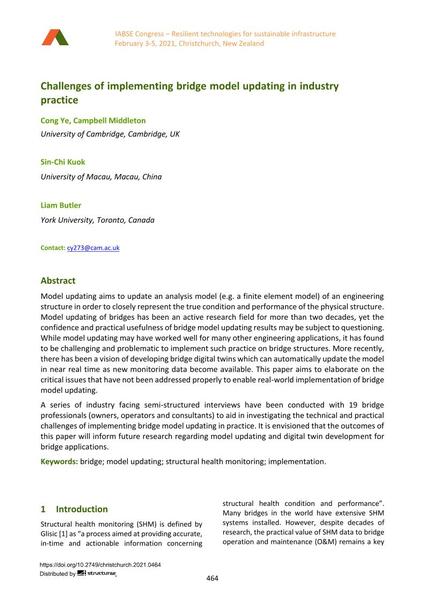Challenges of implementing bridge model updating in industry practice

|
|
|||||||||||
Bibliographic Details
| Author(s): |
Cong Ye
(University of Cambridge, Cambridge, UK)
Campbell Middleton (University of Cambridge, Cambridge, UK) Sin-Chi Kuok (University of Macau, Macau, China) Liam Butler (York University, Toronto, Canada) |
||||
|---|---|---|---|---|---|
| Medium: | conference paper | ||||
| Language(s): | English | ||||
| Conference: | IABSE Congress: Resilient technologies for sustainable infrastructure, Christchurch, New Zealand, 3-5 February 2021 | ||||
| Published in: | IABSE Congress Christchurch 2020 | ||||
|
|||||
| Page(s): | 464-470 | ||||
| Total no. of pages: | 7 | ||||
| DOI: | 10.2749/christchurch.2021.0464 | ||||
| Abstract: |
Model updating aims to update an analysis model (e.g. a finite element model) of an engineering structure in order to closely represent the true condition and performance of the physical structure. Model updating of bridges has been an active research field for more than two decades, yet the confidence and practical usefulness of bridge model updating results may be subject to questioning. While model updating may have worked well for many other engineering applications, it has found to be challenging and problematic to implement such practice on bridge structures. More recently, there has been a vision of developing bridge digital twins which can automatically update the model in near real time as new monitoring data become available. This paper aims to elaborate on the critical issues that have not been addressed properly to enable real-world implementation of bridge model updating. A series of industry facing semi-structured interviews have been conducted with 19 bridge professionals (owners, operators and consultants) to aid in investigating the technical and practical challenges of implementing bridge model updating in practice. It is envisioned that the outcomes of this paper will inform future research regarding model updating and digital twin development for bridge applications. |
||||
| Keywords: |
bridge structural health monitoring model updating implementation
|
||||
